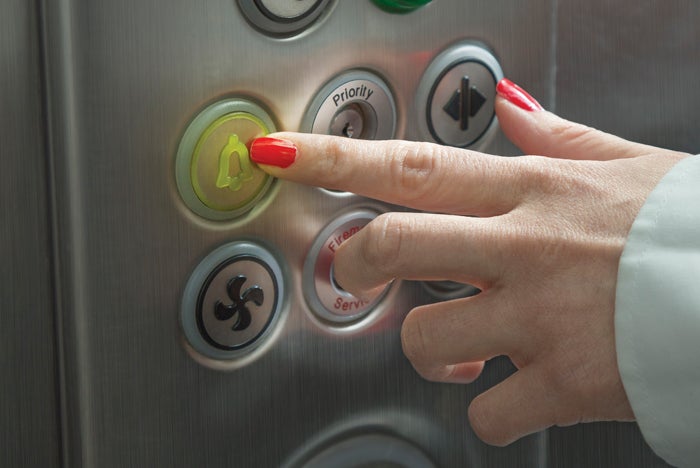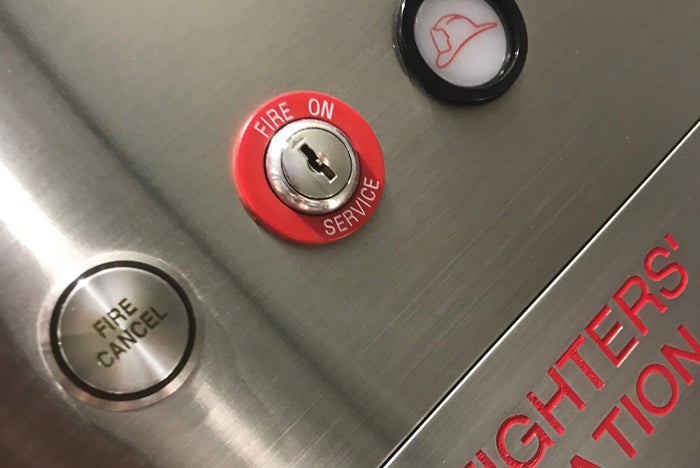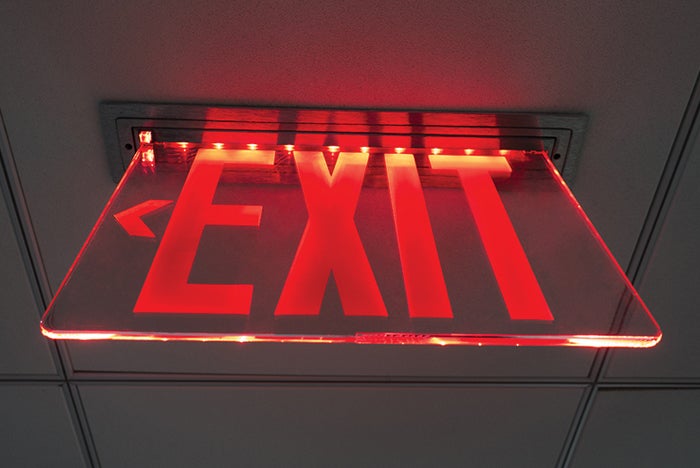Survey examines value of monthly elevator-recall and exit-sign testing

Elevator recall essentially removes control and access to elevators from the public and allows firefighters to take control.
Image by Getty Images
Is there value for the time hospitals spend doing monthly elevator-recall testing and monthly exit-sign inspections? Many hospitals have experienced continuous budget cuts over the past several years, making it difficult to keep up with required preventive maintenance on critical equipment. And yet, this past year, hospitals were asked to comply with additional requirements, including tests and inspections that some feel is little more than busy work.
The American Society for Healthcare Engineering (ASHE) hopes to provoke thought regarding elevator-recall testing and exit-sign inspections in an effort to get involvement of facilities professionals in providing actual testing-data results to help influence a change to the code.
Regarding elevators, for instance, perhaps recall testing is needed only quarterly, semiannually or just annually — once an organization makes repairs after the first monthly testing round. If an organization has been making monthly elevator-recall tests for a long period of time, will the data indicate that the frequency can be reduced or might it indicate the need for even more frequent testing?
Concerning exit signs, ASHE is seeking input on the need for monthly inspection of hospital exit signs. These include signs on emergency power and in buildings occupied 24 hours a day but do not include signs with battery backup, which require a 30-second monthly test and a 90-minute annual test. The request for actual exit-sign inspection data also will consider whether the signs have standard incandescent or fluorescent lamps or long-life lamps, such as light-emitting diodes (LEDs).
Elevator-recall testing
Elevator-recall testing has been required by the American Society of Mechanical Engineers’ ASME A17.1 and Canadian Standards Association’s CSA B44 for many years. However, some health care organizations were unaware of the requirement until the Centers for Medicare & Medicaid Services (CMS) published new K-Tags based on the 2012 edition of the Life Safety Code (LSC).
Although the requirement for elevator-recall testing was also in the 2000 edition of the LSC, because it was not specifically addressed by most authorities having jurisdiction (AHJs), it was simply not a priority. Sometimes, elevator-service companies include this required testing in service-contract agreements and maintain documentation of testing in the elevator machine rooms for state elevator inspections.
Elevator recall, also known as “firefighter’s service” or “firefighter emergency operations,” essentially removes control and access to elevators from the public and allows firefighters to take control. The overall operation of the system is addressed in a number of standards, including ASME A17.1 and ASME A17.3 as well as the National Fire Protection Association’s NFPA 13, NFPA 70, NFPA 72, NFPA 101 and many state and local building codes. It typically is enforced by both the fire department and local or state elevator inspectors.
Firefighter’s service includes two basic sequences: Phase I, which is the recall action; and Phase II, which allows a firefighter to take control of the elevator cab.
Phase I is activated by either a smoke detector in an elevator lobby on any of the floors served by that elevator bank or by the fireman’s key switch located near the elevator hall call in the elevator lobby of the primary and secondary floors (levels that would be utilized by the responding fire department).
Both devices cause all elevators in a bank of elevators sharing the same elevator lobby to immediately travel down to the primary floor where the elevators would stop and the doors would open. A secondary floor for fire department access is also required should a smoke detector in the primary floor’s elevator lobby be in alarm. In that case, all elevators would travel down to the secondary floor where the elevators would stop and doors would open.
Phase II is manually activated inside the elevator cab with the fireman’s key once Phase I has been initiated by either of the previous methods. Once the fireman’s key switch in the elevator is turned on, the elevator can be operated manually by pressing and holding the “door-close” button until the door is fully closed and then pressing the number for the desired floor. Additionally, if the door-close button is released before the doors are fully closed, they will reopen. The elevator will not stop and the doors will not open on a floor where an elevator lobby smoke detector is in alarm.
The monthly test required of all organizations with elevators having firefighter’s service is called a monthly elevator-recall test. However, the phrase “elevator-recall test” is somewhat of a misnomer, as the test requires activation of both Phase I (the recall portion) and Phase II (the in-cab portion) of firefighter’s service.
The monthly elevator-recall test should be performed using the following steps:
- Use the fireman’s key at the firefighter’s service hall station of either the primary or secondary floor and turn it to the “test” position.
- The elevator or bank of elevators will be recalled to the floor where the test was initiated and stop with the doors open.
- Remove the fireman’s key from the hall station, leaving it in the test position and enter an elevator.
- Insert the key in the firefighter’s key switch to take manual control of the cab.
- Push the door-close button until the door is fully closed and then press the number of a desired floor level. Some elevators may require the desired floor number to be pressed and held until the doors are closed.
- Once the elevator travels to the selected floor, it will stop but the doors will not open until the “door-open” button is pressed and held. Once open, the elevator will remain at that floor until another floor is selected as in Step 5.
- While in the elevator, it is a best practice to also test the emergency telephone in the elevator cab.
- Return the elevator to the floor where the test was initiated, remove the fireman’s key and use it to initiate the same operational checks for each of the other elevators in the bank of elevators.
- Once the elevator or all elevators in a bank of elevators have been tested, the fireman’s key again is used in the hall station to return the elevator(s) to service.
- Facilities professionals should check with state or local jurisdictions as some may require a qualified or certified person to do this testing.
Exit-sign inspections
Illuminated exit signs are a code-required, fire-safety feature in all health care facilities. By design, they operate 24 hours per day and may require frequent maintenance due to the service life of their lamps. However, hospitals are staffed 24/7 and when employees are hired, they are typically trained to call the maintenance staff if they identify problems, such as lights or exit signs that are not working.
Even with many eyes watching for lights that are out, many hospital maintenance departments have zone- or area-maintenance programs for making routine checks on each floor to inspect for maintenance and repair issues. Hospitals are thus well-equipped to ensure that exit signs are functioning properly. On the other hand, it is common to see exit signs that are not properly illuminated in restaurants, stores or other places of business.
The requirement for a monthly inspection of exit signs comes from Chapter 7 of the LSC (NFPA 101-2012: 7.10.9), which is one of the fundamental chapters of the code and generally applies to all occupancy types. This requirement was also in previous editions of the code, including the 2000 edition, although it was not typically enforced as it is now by AHJs.
Also, because this code reference indicates that there is an alternative to the monthly inspection if the sign is equipped with a computer-based, self-test/diagnostic program, specifically for battery backup exit signs, there has been an argument that regular monthly inspections do not apply to regular electric exit signs wired to the life-safety branch of emergency power in facilities with emergency generators. However, the Joint Commission has written this monthly inspection into EC.02.05.07 EP1, requiring each individual exit sign to be inspected with written documentation (exception reporting cannot be used).
Although hospitals may have better programs than restaurants, stores or other places of business for ensuring visible and operational exit signs, there is no allowance for having a maintenance staff and employees in the facility at all times who can take action if exit signs are not properly illuminated. All facilities and all occupancy types with exit signs are required to make monthly inspections of their exit signs.
At the same time, many hospitals are converting to long-life, low-energy lamps to save time and energy. According to the Environmental Protection Agency’s Energy Star website, an exit sign with incandescent lamps uses an average of 350 kilowatts (kW) per year and has a lamp service life of only 2.8 months. Exit signs with compact fluorescent lamps are somewhat better, using 140 kW per year with a lamp service life of 10.8 months. However, exit signs using LED lamps use on average only 44 kW per year and have a lamp service life of more than 10 years.
For hospitals, especially those with LED exit signs, it may be appropriate to reconsider the code requirement for a monthly inspection of each exit sign.
(As noted, this is concerned only with hospital exit signs connected to the life-safety branch of the emergency power system. It does not include monthly testing of exit signs with rechargeable batteries. Where emergency lights and exit signs with rechargeable batteries are utilized because there is no emergency generator, egress lights and exit signs must be tested monthly for 30 seconds and annually for 90 minutes according to NFPA 101.)
ASHE needs data
ASHE needs the assistance of facilities professionals who can provide the data required for considering and recommending changes to these codes.
Just as data were used several years ago to justify a change of damper inspection frequency for health care occupancies from every four years to every six years, ASHE’s goal is to determine whether advocacy efforts can help to reduce the burden on busy health facilities professionals.
Organizations can provide the actual results of elevator-recall testing and exit-sign inspections at their facilities to help determine whether ASHE advocacy efforts should address a change to the frequency of elevator-recall testing and exit-sign inspections.
Unless there is a change to the code, elevator-recall testing and exit-sign inspections must continue to be accomplished and documented according to LSC, CMS and Joint Commission EC.02.03.05 EP27 and EC.02.05.07 EP1 requirements.
Wayne Klingelsmith, FASHE, CHFM, MBA, is principal at MSL Healthcare Partners, Barrington, Ill., and a member of the American Society for Healthcare Engineering’s Member Tool Task Force. He can be reached at wklingelsmith@mslhealthcare.com.







